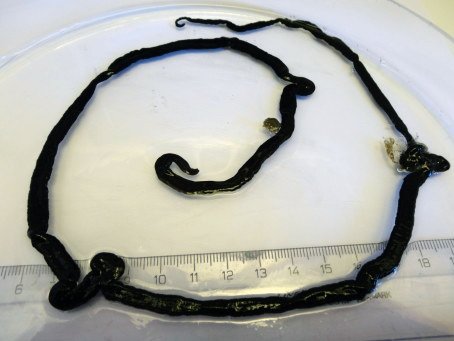
Bootlace worms, known scientifically as *Lineus longissimus*, are long and slender creatures found in the chilly waters of the North Atlantic. They can stretch out to impressive lengths, sometimes hitting 30 meters or more. Despite their size, they can be a bit hard to spot due to their camouflage and the environment they inhabit—think of them as the ninjas of the sea. Their hunting methods are quite extraordinary, making them an excellent subject for anyone curious about the wonders of the natural world.
Understanding Bootlace Worms
Before we get into their hunting tactics, it’s helpful to know a bit about bootlace worms themselves. They’re part of a group called nemerteans, which are known for their long, flat bodies and impressive regeneration abilities. Imagine a worm that can grow back parts of its body if it gets injured—that’s the bootlace worm for you!
These worms prefer to live in sandy or muddy substrates, where they can burrow and hide. The habitat they choose offers both safety from predators and a prime location to ambush unsuspecting prey. Bootlace worms typically feed on small fish, other worms, and even crustaceans. Their hunting strategy is what sets them apart, allowing them to thrive in their environment.
The Role of Mucus in Hunting
At the heart of the bootlace worm’s hunting prowess is its production of *mucus*. This secretion plays a crucial role in their ability to catch prey. You might think of mucus as something that just clogs up your nose when you have a cold, but for bootlace worms, it’s a powerful tool.
When hunting, these worms release a thick, sticky mucus into the water, creating a slick surface that can trap small creatures like fish and crustaceans. Imagine trying to run on a slippery surface—it becomes challenging to escape! This *mucus net* helps immobilize their prey, giving the bootlace worm a chance to spring into action.
So, how does this mucus actually work? The sticky properties allow the worm to entangle its prey. Once the animal is caught, the worm can then approach, ensuring its next meal is secured. This method emphasizes the importance of mucus not just for catching food, but for the overall survival of the bootlace worm.
Toxins: The Secret Weapon
Now, let’s talk about the *toxins* bootlace worms use while hunting. It’s like adding a secret ingredient to a recipe that not only enhances the dish but also makes it downright dangerous for others. The toxins produced by these worms can deter would-be predators and can also incapacitate their prey.
Bootlace worms generate various toxins that are released along with their mucus. When an unsuspecting fish comes into contact with the worm, it can be left stunned or even killed by the potent cocktail. This gives the bootlace worm not only an advantage in catching prey but also a method of ensuring it doesn’t become a meal itself.
You might be wondering how these toxins work. They interfere with the nervous system of their prey, making movement difficult. That’s when the bootlace worm comes in for the catch. This two-pronged attack—using both mucus and toxins—ensures that the bootlace worm is an efficient and effective hunter.
Hunting Techniques in Action
Let’s imagine a scenario that captures the essence of a bootlace worm’s hunting technique. Picture a tranquil underwater scene: the light filters through the water, and small fish swim blissfully unaware of the lurking danger. A bootlace worm, hidden beneath the sand, senses the movement of potential prey.
It starts to release its mucus into the water, creating a slick and sticky film. As a small fish approaches, it suddenly finds itself unable to swim away. The bootlace worm then unleashes its toxins, stunning the fish, and quickly moves in to secure its meal.
This hunting technique showcases the intricate balance of nature. The bootlace worm’s ability to combine mucus with poisonous properties not only illustrates its adaptability but its role in the ecosystem. Without such hunters, the underwater environment could quickly become unbalanced.
Why This Matters for Ecosystems
You might be surprised to learn that the hunting methods of bootlace worms play a significant role in their environment. They help control populations of smaller fish and crustaceans, contributing to the overall health of marine ecosystems. Think of them as an essential piece of the puzzle, helping maintain balance in the underwater world.
Furthermore, the unique adaptations of the bootlace worm can provide insights into other fields of study, such as medicine. Researchers are interested in the toxins produced by these worms because they might hold the key to discovering new pharmaceuticals or treatments.
By understanding how bootlace worms hunt using *mucus and toxins*, we gain a broader perspective on the importance of diverse hunting strategies and their effects on marine life.
Conservation and Future Research
As fascinating as bootlace worms are, they face threats like many other marine species. Environmental changes, pollution, and habitat destruction can impact their populations. It’s crucial to study these creatures further to understand their roles better and help protect their environments.
Researchers aim to learn more about their physiology and hunting methods, which can lead to greater knowledge about marine ecosystems as a whole. With continued study, we might also discover new applications for the toxins they produce, leading to breakthroughs in science and medicine.
By focusing on these remarkable creatures, we’re not just learning about one species but opening the door to a broader understanding of marine life and ecosystems.
Wrap-Up: The Wonders of Nature
In closing, bootlace worms are an incredible example of how nature develops unique strategies for survival. Their use of *mucus and toxins* for hunting is a reminder of the endless creativity found in the animal kingdom. Whether you’re a nature lover, a science enthusiast, or just curious about the world around you, there’s no denying the magic of bootlace worms. They remind us that there’s always more to explore and understand in the natural world—one slimy, slippery worm at a time!
